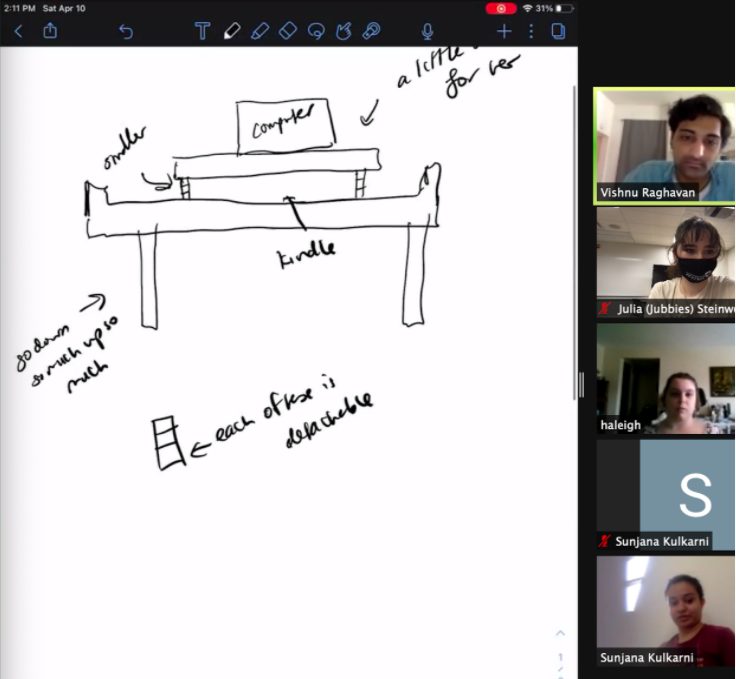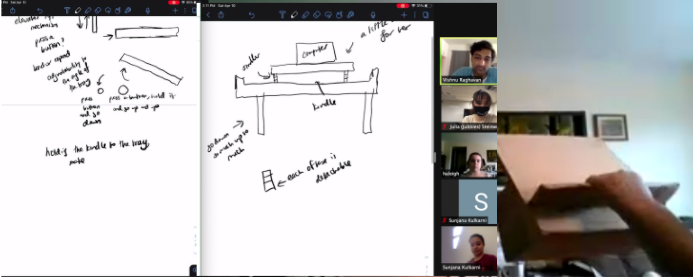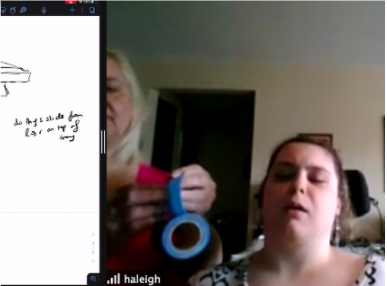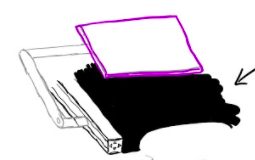A Brief Introduction
The purpose of this final project is to build an assistive device for a specific client that will help them in their daily lives. Our team, the Yews, is comprised of Sunjana, Vishnu, and Julia (Jubbies). Our initial goal was to design and develop a product for our client, Haleigh, that she could use for either enjoyment or for helping her complete necessary tasks, and that would be accessible for her. On Saturday, April 10, we met with Haleigh to get a better understanding of her hobbies, interests, and the activities that take up most of her time. In addition to Haleigh and the three of us, Haleigh’s mom also attended the meeting. One of our team’s goals was to understand the challenges Haleigh faced that could be made easier with a tool we would build. We were also hoping to get more specific and brainstorm ideas for the tool with her during the meeting.
Meeting Agenda
Our meeting agenda was to start out with some icebreakers so that we could get to know each other, along with explaining what our team was hoping to accomplish, and a brief timeline of our team’s work flow. During this time, we planned to ask Haleigh about her hobbies and daily activities. We then planned to segue into asking Haleigh if there was anything challenging in her routine/hobbies that could be made easier with an accessible tool. After this discussion, we had planned to have a collaborative brainstorming session, with everyone taking turns to discuss ideas for some tool(s) while Sunjana shared her screen and drew what people were describing. We then planned to conclude by thanking Haleigh for her time, exchanging contact information, and answering any last-minute questions. We decided not to allot a time limit for any point in our agenda, choosing to keep the meeting flexible.
Actual meeting agenda:
The interview should b 45 mins to an hour, and we should try to get it recorded if she’s ok w that
*actually don’t bother w the roles lmao, keep it flexible*
Intro/Icebreaker – Jubbies
- Thank you for meeting, How are you doing
- Each of our majors/years (all three of us can talk about this, give like 2 second intro)
- We were all really interested in learning robotics, since we were beginners in that area
- We spent a few weeks building a device we could use in our own lives, and we’re
excited to take it one step further and build something useful for you
- @Hailey: Is it okay if this meeting is recorded?
- @Hailey: What are some things you like to do? (we could use this later)
- @Hailey: What led you to want to join this project?
- She thought it sounded interested
Explanation – Vishnu
- We are:
- Trying to build prototype useful devices
- Engaging in an iterative design process, including gathering formative feedback around the midpoint of the process
- Taking about six weeks to go from this meeting to a reasonably high-fidelity (albeit virtual) final product
- Documenting our process
- Capable of simulating somewhat complex electronics via Tinkercad, and more complex physical objects/devices via CAD software
- We are not:
- Professional technologists who are experienced in making polished products
- Planning to build something that will be sold commercially
- Constrained by any practicality outside of usefulness to the person we’re designing for
- Likely to invent a totally novel piece of electronics (we combine many existing available components in new ways, but don’t make components)
- Timeline/overview: Jubbies
- Interview today
- Ideation and prototyping for first half of next week
- Physical prototype development for second half of next week (4/16 – 4/21)
- Final work (4/26 – 5/5)
- Final due 5/5
Vishnu
- If H has given something she likes to do, ask if there’s anything that makes doing her hobby challenging for her?
- @Hailey: What are some activities in your daily life that are frustrating, and that you wish could be made more convenient? (if she hasn’t given an answer to the hobby thing)
- (if they name activity), would you be able to demonstrate for us?
- Ask client why this is important to her (maybe ask this, maybe not, idk)
Vishnu, , Jubbies, and Sunjana
- Three of us brainstorm aloud some solutions to the problem and Sunjana could draw on ipad and screen share, and we ask her if they’re good ideas, and respond to her feedback
Conclusion
Jubbies
- Do you have any questions for us? Or anything you’d like us to clarify
- Thank your client for their time, make sure they have your contact information, and take any final documentation images/drawings/notes you may need to wrap up before you sign off.
- Reiterate the overall project schedule if you feel it would be necessary to clarify before leaving.
Meeting Summary and Major Takeaways
Over the course of our meeting, we discussed the inconveniences Haleigh faces while trying to participate in her hobby of reading as well as learning in school. We found that she is frustrated that when she wants to use a device, the height and viewing angle is not comfortable.
Currently, she has a tabletop computer stand with adjustable legs which essentially raises the height of her tray. However, she cannot adjust them herself so if the height is not comfortable for her, she has to ask another person to take apart her setup and raise the height. Additionally, the current stand’s height is adjusted by adding and removing 1.5” blocks that snap into place. For Haleigh’s diverse needs, this height increment is very limiting and often results in the tray being slightly too low or high. Although the computer is easier to see when it is raised, it is much more uncomfortable to type with.

An orthographic view of Haleigh’s current setup with the adjustable computer stand
Aside from height, Haleigh struggles with using her phone, kindle, or reading from books as the viewing angle is never comfortable for long periods of time. If the device lays flat on the desk requiring her to look down at it, this is comfortable for her arms, but causes neck straining. If the device is propped up, it may be easier for her neck, but it can be uncomfortable for her arms to stretch out forward after a while. Ultimately, Haleigh desires a solution to help her achieve a comfortable viewing angle that also allows her to use the device without stretching her arms in an unsustainable position. In our discussions, we also found that Haleigh would enjoy the ability to make micro adjustments to her setup by herself, so she could tailor the height and angle of her tray top to her specific needs.

Haleigh used to use this stand for using her phone and reading, but found it wasn’t comfortable and it would slide around.
Another consideration placing things on top of her tray is the concern of the apparatus sliding from left to right. Haleigh’s mom has found that carpet tape seems to do a great job at holding Haleigh’s items in place for a while. She noted that this tape must be replaced after it loses its stickiness, but works well for the most part.

Haleigh’s mom showing the repurposed carpet tape
Reflection
The interview was very easy to dive into; Haleigh was very warm and welcoming, and we got right down to inquiring about her life, hobbies, and current situation. All three of us felt quite comfortable asking clarifying questions and follow ups during the interview, and Haleigh was quite eager to help us on that front. We also made sure to ask for a physical presentation of her physical situation—specifically, showing us how her current tray made using and typing on tablets quite difficult. This was a good avenue of questioning, as it helped us ground our project in the real world, instead of just hypothetically discussing constraints. In other words, we could see how tall our device could expand and retract, and also how much weight the object could be without collapsing the tray. Another important strategy was to emphasize an open line of communication with Haleigh—if we had felt we forgot to ask her something or left something out, or if she had any clarifying questions, we could always email back and forth even after the interview.
